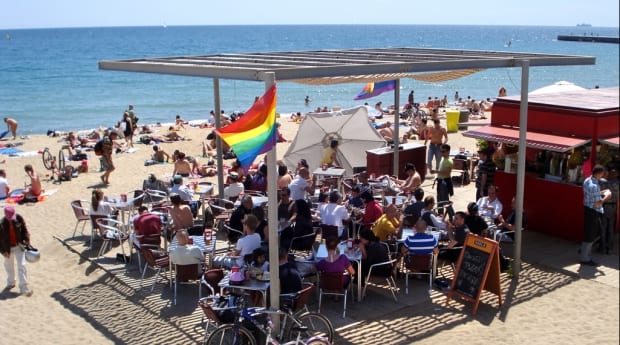Barcelona remains Spain’s most popular city for tourists, even if it isn’t the country’s largest gay party destination. That title belongs to Madrid’s Chueca district, but the comparison is as distorted as the facade on one of Barcelona’s famous Modernista buildings.
Barcelona’s number and variety of LGBT bars, saunas and businesses might lag behind Madrid, but a gay visitor doesn’t need to look far to see where the load is shared. Less than an hour from Barcelona by train, Sitges is one of Europe’s favourite gay resort towns, while LGBT visitors from around Europe keep Ibiza, Majorca and other Mediterranean islands buzzing with events held throughout the year.
But unless you’re heading to the islands specifically, Barcelona will be your most likely entry point, and if you only have limited time, it deserves your focus. The city reveals itself in layers, from its astonishing architecture, to the complex history of the Barri Gothic, a modern art scene that continues to astonish decades after Dali, Picasso and Miro, to La Barceloneta, and the relatively recent addition of the city’s man-made beach.
Pro-LGBT attitudes have characterised Barcelona throughout much of the 20th century. During the difficult years of the Franco regime, it served as a major centre of tolerance and acceptance, alongside neighbouring Sitges and Ibiza, though Spain’s first gay bar can be traced to the southern city of Torremolinos.
Spain has emerged rapidly in the last 40 years as one of the world’s most accepting destinations for LGBT folk. Surveys show that beyond welcoming its tourists, Spain is one of Europe’s most pro-queer societies as well. This easy-going attitude is palpable everywhere in Barcelona’s changing cityscape: same-sex couples stroll the Ramblas hand in hand, works exploring sexual diversity are a fixture in the city’s many art galleries, and even the city’s churches barely raise a peep against LGBT people.
That mainstream acceptance, however, hasn’t brought the curtains down on the city’s main gay neighbourhood, a grid within L’Exaimple, perhaps predictably nicknamed Gaixample. Compared to the sometimes frenetic Chueca, Gaixample has a more laid-back, neighbourhood feel as you wander from one intersection to the next, admiring the architectural patchwork that characterises each illes, or manzana, as the city blocks here are known. A broad mix of gay bars, saunas, clothing and sex shops dominate, alongside friendly restaurants and hotels including the “straight-friendly” Axel Hotel, which opened its first property in Gaixample in 2003. Axel’s rooftop Sky Bar is open to the public during the summer, and it’s one of the city’s most popular gay spaces during the peak tourist season.
Partly due to its hotel location, Sky Bar peaks early by Barcelona standards, and by midnight, everyone has moved on to the appropriately named Dietrich. Toss back a few confessions at the charmingly blasphemous La Chapelle, or join the trendy young crowd at Punto BCN. With eye-catching bartenders and well-priced drinks, Punto is one of Barcelona’s larger, more popular mainstream gay bars, and while it lacks the character of some of its competitors, it’s a must-stop if you plan on dancing the night away. An early drink here will typically come with a discounted or free entry to one of the two gay discos in town, Arena and Metro, but don’t rush. Remember, you’re still in Spain. Most of the city’s dancefloors will be empty until 2am.
Smaller, relaxed cocktail bars abound throughout Gaixample, while those looking for a more down and dirty evening might prefer Night, or one of the saunas such as Casanova. These typically offer a variety of relaxation services and therapies beyond dark cruise spaces, though these tend to peak earlier in the evening before the bars start hopping — a great way to recharge after a heavy sightseeing day.
For sightseeing, Gaixample boasts one of the best locations for staying in Barcelona. Hotels are considerably cheaper than in the Barri Gothic, yet place you no more than a 15-minute walk away from the city’s landmarks. The Gothic quarter is Barcelona’s most famous neighbourhood and deserves a good chunk of your time, though the ancient laneways can lose their charm under the tourist swarm. You’re also within walking distance of the Museu Picasso and the Barcelona Museum of Contemporary Art, while Parc de la Ciutadella stretches along the far side of the district, where Barcelona’s own Homomonument opened in 2011. Gaudi enthusiasts staying in Gaixample will be similarly close to Casa Batllo and La Pedrera, with Palau Guell and Sagrada Familia both within a pleasant half-hour walk.
For the most up-to-date travel information on gay Barcelona, see our City Guide, Listings Guide, Events Guide and Activities Guide.
For more information, read What is a good time of year to visit Spain?

 Why you can trust Xtra
Why you can trust Xtra